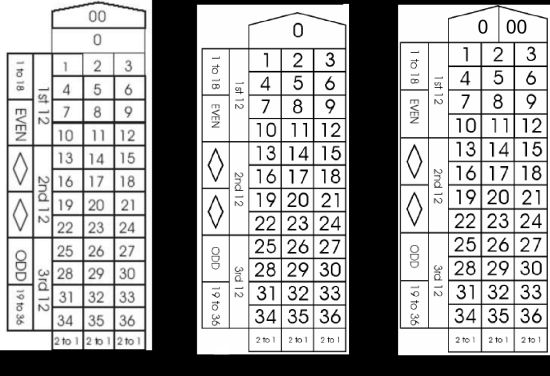On 16 October 2020, in the decision of Crown Melbourne Limited [2020] APO 47, the Australian Patent Office refused a patent application by casino owner Crown Melbourne Ltd for a new roulette table layout after it found that the new layout did not provide any mechanical or technical benefit and therefore was not a manner of manufacture. The decision demonstrates that even physical inventions, especially games, may not be patentable in Australia if they do not deliver a technical innovation.
The new roulette table layout
Figure 1 below shows the roulette table layout that Crown Melbourne sought to patent, alongside the traditional single-zero and double-zero layouts. The new layout differed from the double-zero original in that the 00 space did not share a boundary with the 2 and 3 spaces. This variation was said to add betting options that were available in the single-zero but not in the original double-zero game, which would have allowed players accustomed to the single-zero game to transition more easily to a layout with a 00 space, giving the house an extra edge.

Figure 1. (a) New roulette table layout; (b) traditional single-zero layout; (c) traditional double-zero layout. The figures are from Crown Melbourne's patent application, AU 2018219972.
Claim 1 of the patent application defined the new table layout as follows:
A Roulette apparatus comprising a table layout adapted for placing wagers, the table layout comprising:
first elements comprising individual numbered wagering spaces for accommodating individual indicia from one (1) to thirty-six (36);
a second element comprising an individual numbered wagering space for accommodating a double zero indicia; and
a third element comprising an individual numbered wagering space for accommodating a single zero indicia, wherein the third element is configured relative to the first and second elements to form a common boundary with a subset of the first elements and to exclude the second element from contact with the subset of first elements.
The patent application also contained claims directed to a roulette wheel with a new pocket number sequence and a method claim for playing roulette with steps ranging from "placing wagers on a table layout" to "introducing a ball to the spinning Roulette wheel".
All the claims were held to be novel and inventive during examination of the patent application, the only objection being that they did not define a manner of manufacture.
Form versus substance
The High Court of Australia, in the landmark decision of D'Arcy v Myriad Genetics Inc [2015] HCA 35, has spoken of the need to look to the substance of the invention rather than the form expressed by the words of the patent claims.
In the present case, the Hearing Officer acknowledged that the invention, in form, was not an abstract idea or scheme, given that the claims defined a physical apparatus. However, in substance the invention was deemed to be a layout of wagering spaces.
The Hearing Officer seems to have characterised the substance by focussing on the features of the invention that distinguished it from the prior art (i.e. the traditional double-zero layout), despite this approach having been rejected in the recent Federal Court decisions of Commissioner of Patents v Rokt Pte Ltd [2020] FCAFC 86 and Aristocrat Technologies Australia Pty Limited v Commissioner of Patents [2020] FCA 778.
No mechanical or technical benefit
The Hearing Officer then considered the nature of the contribution made by the substance of the invention. In summary, he held that the purpose of the new table layout was to increase the number of betting options compared to traditional double-zero roulette games. The Hearing Officer concluded that the invention's substance did not provide any mechanical or technical benefit.
An argument had been made by Crown Melbourne's representative that the invention served a mechanical function because it allowed an extended possibility of bets to be placed by the laying down of gaming chips onto the table layout, but the Hearing Officer disagreed, noting that that functionality was not due to any action performed by the roulette table.
The other main physical feature of the claims, the roulette wheel, was quickly dismissed in the decision reasoning. The Hearing Officer asserted that the invention's variation to the wheel was limited to the pocket numbering and there was no working relationship between the wheel and the table layout.
In the end, the patent application was refused for failing to define any patentable subject matter.
Take-home points
In Australia, even an invention that has physical form, such as a game or computer-implemented invention, can in substance be said to amount to non-physical features. This alone does not disqualify such an invention from patent protection, but it is usually required that the non-physical substance provide some mechanical or technical benefit, beyond an economic or business-efficiency advantage.
The approach taken by the Hearing Officer in this decision however is questionable in view of recent Federal Court decisions, which you can read about here and here.
The content of this article is intended to provide a general guide to the subject matter. Specialist advice should be sought about your specific circumstances.


